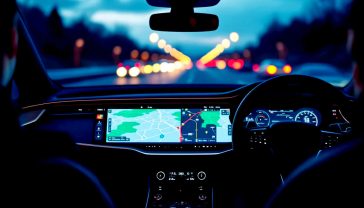The GPS Tracker Guide for UK Buyers: Stay Informed, Stay Tracked
Your complete guide to choosing and using a GPS tracker in the UK. We cover vehicle, pet, and personal trackers, key features, and the law.

This post may contain affiliate links. If you make a purchase through these links, we may earn a commission at no additional cost to you.
Ever had that heart-stopping moment when you can’t find your keys? Or worse, your dog has vanished from the park? Or that sinking feeling when you can’t remember where you parked the car in a massive multi-storey? We’ve all been there. It’s that little panic that makes your stomach flip. For generations, we just had to hope for the best. But today, we’ve got something straight out of a spy film to help: GPS trackers.
These clever little gadgets are no longer just for spies and big-shot delivery companies. They’re for everyone. They’re for keeping your prized caravan safe from thieves, making sure your adventurous cat comes home for tea, and giving you peace of mind when a vulnerable relative goes for a walk. Think of a GPS tracker as your own personal search party, tucked into a tiny box. It uses satellites whizzing around the Earth to pinpoint exactly where your stuff—or your loved ones—are, and sends that location right to your phone.
But with so many options out there, how do you choose the right one? What’s the difference between a £20 gizmo from Amazon and a £200 system with a monthly fee? And is it even legal to track something or someone in the UK? Don’t worry. We’re going to break it all down. This guide is your one-stop shop for everything you need to know about GPS trackers. We’ll cover how they work, what to look for, and how to use them legally and safely right here in the UK. Let’s get started.
What on Earth Is a GPS Tracker and How Does It Actually Work?
It sounds like magic, but it’s really just clever science. A GPS tracker is a small device that figures out its own location and then tells you where it is. To do this, it juggles three bits of technology: satellites, a SIM card, and your smartphone.
The Satellites: Your Eyes in the Sky
First up is the Global Positioning System (GPS). This is a network of about 30 satellites orbiting our planet, put there by the US government. These satellites are constantly beaming signals down to Earth. They’re like lighthouses in space, and your GPS tracker is like a ship at sea.
The tracker picks up signals from several of these satellites at once. By measuring the tiny differences in the time it takes for each signal to arrive, the tracker can do some clever maths—a process called trilateration—to calculate its exact position. It’s incredibly accurate. To get a good fix, it needs a clear view of the sky to ‘see’ at least four satellites. That’s why a tracker might struggle a bit inside a concrete garage or deep in the London Underground, but works perfectly outdoors.
The SIM Card: Phoning Home with the Location
Okay, so the tracker knows where it is. But how does it tell you? That’s where the second bit of tech comes in: a SIM card, just like the one in your mobile phone.
Inside most GPS trackers is a tiny SIM card that connects to a mobile network (like EE, Vodafone, or O2 here in the UK). Once the tracker has its location from the satellites, it uses the mobile network to send that information to a secure server on the internet. It’s basically sending a little text message or a tiny packet of data saying, “Hi, I’m at these coordinates!”
This is why most trackers need a subscription or a monthly fee. You’re paying for the data the SIM card uses to send its location updates. Some use very little data, so the cost can be just a few pounds a month.
Your Phone: The Mission Control Centre
The final piece of the puzzle is you. The location data is sent from the tracker to a server, and you can access it through an app on your smartphone or a website on your computer.
You simply log in, and you’ll see a map with a pin showing exactly where your tracker is. It’s like having your own personal version of Google Maps, but for your most valued possessions. Most apps let you do all sorts of cool things, like see where the tracker has been, get alerts if it moves, or even set up ‘safe zones’.
So, in a nutshell:
- Satellites beam signals down.
- The GPS tracker catches them and figures out its location.
- A SIM card inside the tracker sends this location over a mobile network.
- You see the location on a map on your phone.
It’s a simple but brilliant system that gives you the power to find almost anything, anywhere in the world.
The Different Flavours of GPS Trackers: Which One Is for You?
GPS trackers aren’t all the same. They come in different shapes and sizes, each designed for a specific job. Think of it like buying a car—you wouldn’t use a little city run-around to haul bricks, and you wouldn’t drive a massive lorry to the local Tesco. Choosing the right tracker depends entirely on what you want to track.
Let’s look at the main types you’ll find in the UK.
For Your Wheels: Vehicle Trackers
Our cars, vans, motorbikes, and caravans are often our most expensive possessions after our homes. So it’s no wonder vehicle trackers are hugely popular. They’re all about security and peace of mind.
- Hardwired Trackers: These are the real heavy-hitters. They are wired directly into your vehicle’s electrical system by a professional (or a confident DIY-er). Because they’re powered by the car battery, you never have to worry about them running out of juice. They’re often hidden away under the dashboard or in the engine bay, so a thief would have a tough time finding and removing one. Many insurance companies love these and might even give you a discount for having one fitted, especially for high-value cars. Look for devices that are Thatcham-approved, as this is the seal of approval for vehicle security here in the UK.
- Plug-in Trackers (OBD Trackers): If you don’t fancy messing with your car’s wiring, these are a brilliant alternative. Most cars made after 1996 have an On-Board Diagnostics (OBD) port, usually tucked away under the steering wheel. You just plug the tracker in like a USB stick. It takes seconds to install and draws power from the car. The only downside is that a savvy thief might know to look for it and unplug it.
- Magnetic Battery-Powered Trackers: These are the secret agents of the tracker world. They are completely wireless and have powerful magnets, so you can just slap one onto a metal surface on your vehicle—under the chassis, in the boot, or tucked away in a wheel arch. Their big advantage is flexibility; you can move them between vehicles easily. But you do need to remember to charge them. Their battery life can range from a couple of weeks to several months, depending on the model and how often it reports its location.
For Your Furry Friends: Pet Trackers
Losing a pet is every owner’s worst nightmare. A GPS pet tracker can be a real lifesaver, especially for cats who love to roam or dogs who have a habit of chasing squirrels a bit too far.
- Collar-Mounted Trackers: These are the most common type. They are small, lightweight boxes that clip or slide onto your pet’s existing collar. They need to be tough, waterproof (for all those muddy puddle adventures), and light enough that they don’t bother your pet. Most weigh about the same as a couple of £1 coins. They have a rechargeable battery that usually lasts for a few days to a week. The associated app often includes features like an activity monitor (to see if your lazy Labrador has actually been for a run) and a virtual fence (which alerts you if your pet wanders out of the garden).
For People and Possessions: Personal and Asset Trackers
This is a broad category for all the other things you want to keep an eye on. These trackers are usually small, battery-powered, and designed to be discreet.
- Personal Trackers for Loved Ones: These are designed with people in mind. They are often used for children on their way to school, elderly relatives with dementia, or lone workers in remote areas. They are small enough to be put in a pocket, a school bag, or worn as a pendant. Many have an SOS button. When pressed, it sends an immediate alert with the person’s location to a designated contact. Some even allow two-way communication, like a very simple mobile phone.
- Asset Trackers for Your Valuables: This is for everything else you can’t bear to lose. Think expensive camera gear, a tool-filled van, your golf clubs, or even your luggage when you’re jetting off from Heathrow. These trackers are often simple, compact, and have a very long battery life—sometimes lasting for months or even years on a single charge. This is because they often ‘sleep’ and only wake up to report their location once or twice a day, or when they detect movement.
- Bluetooth ‘Finders’ (A Quick Mention): It’s important not to confuse GPS trackers with Bluetooth finders like the Apple AirTag or Tile. These are great for finding your keys down the back of the sofa, but they have a very short range (about 30 feet). They work by piggybacking on a network of other people’s phones. If your lost item comes near someone else with the same app, you’ll get a location update. They’re clever, but they’re not real-time GPS. For tracking something valuable that could be stolen and taken miles away, you need a proper GPS tracker.
Key Features to Look For: Don’t Buy Blind!
When you start shopping, you’ll see a blizzard of features and technical terms. It can be confusing. Let’s cut through the noise and focus on what really matters for a UK buyer.
1. Real-Time Tracking and Update Speed
This is the big one. Real-time tracking means you can see the tracker moving on the map as it happens. But how ‘real-time’ is it? This depends on the update speed—how often the tracker sends its location.
- For a car or motorbike, you’ll want updates every 10-30 seconds to follow it smoothly.
- For a pet, updates every 2-3 minutes might be fine when they’re just pottering about, but you’ll want a ‘live’ mode with faster updates if they go missing.
- For an asset like a caravan in storage, an update once a day might be all you need.
Faster updates give you a more accurate picture, but they use more battery and data, which can increase the subscription cost. Look for trackers that let you adjust the update frequency.
2. Geofencing: Your Virtual Boundaries
This is a brilliantly useful feature. A geofence is a virtual boundary you draw on the map in your app. For example, you could draw a circle around your home, your child’s school, or the field where you keep your horse.
When the tracker enters or leaves this pre-defined area, you get an instant notification on your phone. It’s perfect for:
- Getting an alert if your car is moved from your driveway in the middle of the night.
- Knowing your child has arrived safely at school.
- Being warned if your dog has escaped from the garden.
3. Battery Life and Power Source
A tracker is useless if its battery is dead. The battery life advertised by manufacturers can be optimistic, so always read reviews from real users.
- Hardwired trackers are the best as they run off the vehicle’s battery.
- Rechargeable trackers are the most common for personal and pet use. Battery life can be anything from 24 hours to a few weeks. Think about how often you’re prepared to charge it. Is it for daily use or just for occasional trips?
- Long-life asset trackers can last for years. They achieve this by using special low-power technology and only waking up periodically. They are ‘fit and forget’ devices.
4. Size, Weight, and Durability
The physical design of the tracker is crucial.
- For a pet, it needs to be small and lightweight.
- For a vehicle, a magnetic tracker needs powerful magnets to ensure it doesn’t fall off on a bumpy British country road.
- For anything used outdoors, it must be waterproof. Look for an IP rating. IP67, for example, means it’s fully protected against dust and can be submerged in 1 metre of water for 30 minutes.
5. The App and Software: Your User Experience
The best hardware in the world can be let down by a clunky, confusing app. The app is how you’ll interact with your tracker every day.
- Ease of Use: Is the app intuitive and easy to navigate? Can you easily see the location, history, and settings?
- Features: Does it offer everything you need, like geofencing, speed alerts, and battery level indicators?
- History: Most trackers will store a history of where they’ve been. This can be useful for seeing your dog’s secret route through the neighbourhood or checking a teenage driver’s journeys. How long is the history stored for? 30 days? 90 days? A full year?
- UK Support: If something goes wrong, can you get help from a UK-based support team? This can be a huge advantage over cheaper, generic trackers sold online.
6. Costs and Subscriptions: The Full Picture
Don’t just look at the initial price of the tracker. You need to factor in the ongoing costs.
- The Device Cost: This is the one-off payment for the tracker itself. It can range from £30 to over £200.
- The Subscription Fee: This is the monthly or annual fee for the SIM card’s data plan and access to the tracking platform. It’s typically between £4 and £10 per month. Some companies offer a discount if you pay for a year or two upfront.
- Pay-As-You-Go (PAYG): Some trackers come with a PAYG SIM card, where you just top up the credit as you need it. This can be cheaper if you only need to use the tracker occasionally, but it can be a faff to manage.
- ‘All-in-One’ Deals: Some companies sell the tracker with a lifetime subscription included in the purchase price. This seems great, but make sure the company is reputable and likely to be around for the long haul!
Always calculate the total cost of ownership over a year or two to compare different options fairly. A cheap tracker with a high monthly fee can quickly become more expensive than a pricier device with a cheaper plan.
The Legal Side of Things in the UK: Can I Track That?
This is a really important question. Using a GPS tracker is perfectly legal in many situations, but you can get into very hot water if you use one incorrectly. The law in the UK is all about consent and ownership.
Here’s a simple breakdown.
Tracking Your Own Property: Green Light
You are legally allowed to place a tracker on your own property. This is the most common use.
- Your car, motorbike, or caravan? Absolutely fine. It’s your property, and you’re using the tracker for security.
- Your pet? Yes. Legally, pets are considered property, so putting a tracker on your own dog or cat is fine.
- Your tools, luggage, or other assets? Go for it.
Tracking a Vehicle You Co-own: It’s Complicated
What if you share a car with your spouse or partner? This is a grey area. If you both own the car and both agree to have a tracker, that’s fine. However, if you place a tracker on a shared car to monitor your partner’s movements without their consent, you could be breaking privacy laws and potentially engaging in stalking or coercive behaviour, which are serious criminal offences. The golden rule is communication and consent.
Tracking Your Employees: Handle with Care
If you run a business and want to track company vehicles, you generally can, but you have to follow strict rules under the Data Protection Act and GDPR.
- You must have a legitimate business reason for tracking (e.g., logistics, security of the vehicle, or verifying work hours).
- You must inform your employees that the vehicles are tracked. This should be clearly stated in their employment contract or a company policy document.
- The tracking should generally be limited to working hours. Tracking an employee’s private use of a company van on their weekend off is likely illegal.
- You cannot use the data for any purpose other than what you’ve stated.
Tracking People (Adults and Children): Consent Is King
This is where the law is most strict.
- Tracking an Adult: You cannot place a tracker on a person or their property (like their car or bag) without their explicit consent. Doing so is a serious breach of their privacy and could lead to civil action or even criminal charges for harassment. It doesn’t matter if you’re married to them or you suspect them of something. No consent means no tracking.
- Tracking a Vulnerable Adult: If you are the legal guardian or have Power of Attorney for an adult who lacks the mental capacity to give consent (e.g., someone with advanced dementia), using a tracker for their safety is generally acceptable. However, it must be in their best interest.
- Tracking Your Own Children (Under 18): As a parent, you can legally use a GPS tracker to monitor your own minor child. The law considers this part of your parental responsibility to keep them safe. However, it’s always best to have an open conversation about it with older children and teenagers, explaining that it’s for their safety, not to spy on them. Trust is a two-way street.
In summary, the key legal test in the UK is this: Do you own the item, and/or do you have explicit consent from the adult being tracked? If the answer is no, then don’t do it.
Putting It All Together: A Quick Buyer’s Checklist
Feeling a bit overwhelmed? Don’t be. Here’s a simple checklist to walk you through the process of choosing and buying the right GPS tracker.
- What am I tracking? (A car, a cat, a person, an asset?)
- This will determine the type of tracker you need (hardwired, collar-mounted, personal).
- What are my most important features? (Real-time tracking, long battery life, geofencing, an SOS button?)
- Make a list of your ‘must-haves’ and ‘nice-to-haves’.
- How much am I willing to spend?
- Remember to calculate the total cost: the device price + the subscription fee over at least one year.
- How tech-savvy am I?
- Do I want a simple ‘plug and play’ device or am I comfortable with a more complex installation?
- Have I checked the reviews?
- Look for reviews from UK customers on sites like Trustpilot or Amazon. Pay attention to comments about battery life, app reliability, and customer service.
- Do I understand the legal side?
- Am I tracking my own property? Do I have consent if I’m tracking another person?
The Future of Tracking: What’s Next?
GPS technology isn’t standing still. The trackers you buy today are smaller, more accurate, and have better battery life than ever before. But what does the future hold?
We’re seeing a move towards even smaller devices with longer battery life, thanks to new low-power network technologies like NB-IoT and LTE-M, which are rolling out across the UK. These are designed specifically for devices like trackers that only need to send small amounts of data.
We can also expect trackers to become smarter. They won’t just tell you where something is; they’ll learn its routines. Imagine a tracker that knows your car should be on the driveway overnight and automatically alerts you if it moves, without you needing to set a geofence. Or a pet tracker that learns your cat’s territory and alerts you if it strays into a dangerous area, like a busy road.
The integration with other smart home technology is also on the horizon. Your car tracker could tell your Nest thermostat you’re on your way home, so it turns the heating on. The possibilities are endless.
For now, though, the power of GPS tracking is already in your hands. It offers a simple, affordable, and effective way to protect the things that matter most. Whether it’s the family car, the family dog, or a vulnerable member of the family, a small, unassuming box can provide invaluable security and, most importantly, peace of mind.
Further Reading
For those who wish to delve deeper, here are some highly respected UK-based resources:
- Thatcham Research: The UK’s experts in vehicle security and testing. https://www.thatcham.org/
- The Information Commissioner’s Office (ICO): The official body for data protection and privacy in the UK. https://ico.org.uk/
- The Alzheimer’s Society: Provides guidance on using technology to help people with dementia. https://www.alzheimers.org.uk/
- The Suzy Lamplugh Trust: A leading UK charity on personal safety, with information relevant to lone worker tracking. https://www.suzylamplugh.org/






